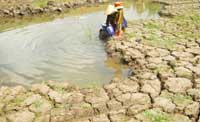INDOCHINA INTERNATIONAL CONSULTING CO., LTD
HO Add: 62L/36 Nguyên Hồng, Ward 11, Bình Thạnh District, HCMC - Vietnam
Biz Office Add: #48 Road No 11, Quarter 6, Hiệp Binh Chánh Ward, Thủ Đức, HCMC - Vietnam
®Source: http://viipip.com should be clearly quoted for any use of information extracted from our website.
Publication permit No: 60/GP-TTĐT , April 05, 2010.


Resident in Can Tho city’s Co Do district facing infiltrated seawater, a consequence of climate change. The city authority is putting together maps in order to deal with its consequences.
The Can Tho Steering Committee for Climate Change recently made the decision to create the maps in order to identify areas which will be impacted the most by climate change and minimise the consequences of natural disasters.
With technical support provided by the World Bank (WB), the new urban area in the south of Can Tho river, Tra Noc ward and other ancient wards in the city centre will each have a set of maps which include four digital maps on current material facilities, economic regions, the history of natural calamities in the past, and a map including future development plans.
These maps are expected to be used to develop priority programmes on coping with climate change and to call for investment and assistance, according to the WB.
Ky Quang Vinh, director of the city’s Natural Resources and Environment Monitoring Centre, said the steering committee chose those three locations for the initial mapping, because they had high residential density, important infrastructure and were considered most vulnerable to climate change.
“Creating a scenario for people to cope with climate change based on the maps is urgent. The sooner the risks of climate change are uncovered, the sooner people are provided with guidelines to prevent and mitigate the consequences of climate change,” said Vinh. He said the set of maps would definitely be completed by the end of the month despite lack of staff and financial shortages.
The WB has already published a handbook detailing plans to make Can Tho, Ha Noi, and Dong Hoi the nation’s first climate-change resilient cities by reducing vulnerability to climate change and natural disasters.
This practical guide to reducing disaster risk is meant to provide city planners, administrators and communities with a better understanding of climate change.
By 2100, the average temperature in Viet Nam would increase by 3 degrees Celsius and the sea level would rise by an additional one metre, predicted director of the Institute of Meteorology, Hydrology and Environment Tran Thuc.
“Then, the entire Mekong Delta would be inundated and 1,700sq.km of the Red River Delta would be affected,” said Thuc.
- FDI capital continues to pour into Vietnam (6/11/2025 1:20:33 PM)
- Thanh Hoa receives good news: Preparing to have an additional industrial park of up to 470 hectares, creating jobs for nearly 30,000 people (6/11/2025 1:15:09 PM)
- Industrial Park Real Estate: Waiting for the New Generation of FDI (6/11/2025 1:10:15 PM)
- A wealthy Vietnamese city will have two special economic zones after the merger (6/11/2025 1:04:42 PM)
- 30 billion USD capital FDI in Việt Nam by 2025, a series of "ông big" races to expand the land fund (6/11/2025 12:55:26 PM)
- the 2nd largest city in the North will start construction on an international economic zone (6/11/2025 12:50:20 PM)
- Japanese giant Sumitomo continues to want to build an industrial park in the countrys fourth smallest province. (6/11/2025 12:40:45 PM)
- 3 foreign corporations want to invest billions of dollars in Ba Ria - Vung Tau (6/11/2025 12:34:30 PM)
- Lotte Group member starts construction of nearly 1,000 billion VND logistics center in the province with the most industrial parks in Vietnam (6/11/2025 12:33:26 PM)
- Forming a regional center for manufacturing spare parts and components (6/11/2025 12:24:08 PM)
- Vietnams first wafer factory is about to start construction (6/11/2025 12:19:09 PM)
- Dong Nai attracts foreign investors (6/11/2025 12:13:27 PM)
- Tay Ninhs largest industrial park welcomes a $150 million high-end knitted fabric factory project (6/11/2025 12:11:00 PM)
- (6/11/2025 12:09:10 PM)
- Vietnam will become a destination for Chinese investors in the future (11/6/2023 1:03:19 PM)

- FDI capital continues to pour into Vietnam
- Thanh Hoa receives good news: Preparing to have an additional industrial park of up to 470 hectares, creating jobs for nearly 30,000 people
- Industrial Park Real Estate: Waiting for the New Generation of FDI
- A wealthy Vietnamese city will have two special economic zones after the merger
- 30 billion USD capital FDI in Việt Nam by 2025, a series of "ông big" races to expand the land fund










 ADB: Vietnam’s 2009 GDP growth to be highest in South East Asia
ADB: Vietnam’s 2009 GDP growth to be highest in South East Asia MGM Grand Ho Tram: Vietnam’s First ‘Las Vegas Style’ Integrated Resort
MGM Grand Ho Tram: Vietnam’s First ‘Las Vegas Style’ Integrated Resort Nha Trang’s Twin Towers project licenced
Nha Trang’s Twin Towers project licenced Foreign investors still have good opportunities in Vietnam
Foreign investors still have good opportunities in Vietnam Sierra Wireless gets a foot in Vietnam’s ICT market
Sierra Wireless gets a foot in Vietnam’s ICT market